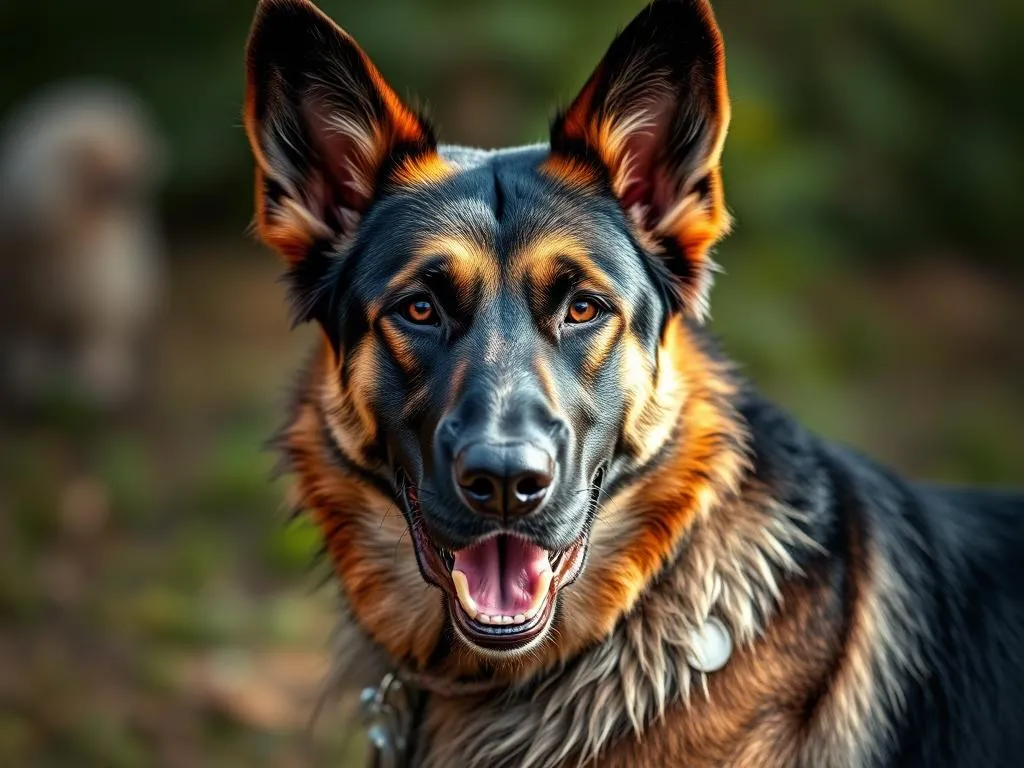
Dogs are often referred to as man’s best friend, a title that speaks to their deep-rooted significance in human society. From loyal companions to skilled service animals, dog breeds are tailored to meet various needs and preferences. Among the diverse varieties, one hybrid breed that has gained considerable attention is the German Sheprador. This unique mix of the German Shepherd and Labrador Retriever offers a blend of qualities that can be both charming and practical for potential pet owners. Understanding mixed breeds like the German Sheprador is essential in today’s pet ownership landscape, where hybrid dogs are becoming increasingly popular.
Understanding Dog Breeds
What is a Dog Breed?
A dog breed is a specific group of domestic dogs that have unique characteristics, traits, and behaviors that distinguish them from other breeds. This classification is the result of selective breeding practices that began thousands of years ago. Historically, dogs were bred for specific tasks such as herding, hunting, and guarding, which shaped their physical and behavioral traits.
The Importance of Dog Breeds
Dog breeds play an essential role in companionship and service. Many breeds have been specifically developed to assist humans, whether as therapy dogs, assistance dogs for individuals with disabilities, or search and rescue dogs. Each breed carries genetic traits that influence their temperament, energy levels, and behavior, making it important for prospective owners to understand breed characteristics when choosing a dog.
Overview of Hybrid Breeds
Hybrid dog breeds, often referred to as designer breeds, are the result of crossbreeding two different purebred dogs. The German Sheprador is one such hybrid, combining the intelligence and loyalty of the German Shepherd with the friendly and playful nature of the Labrador Retriever. While hybrids can inherit traits from both parent breeds, they may also exhibit unique characteristics that set them apart. Owning a hybrid dog comes with both benefits, such as hybrid vigor, and considerations, like potential health issues from either parent breed.
Introduction to the German Sheprador
What is a German Sheprador?
The German Sheprador is a delightful crossbreed between the German Shepherd and the Labrador Retriever. This hybrid often inherits the best traits of both breeds, making them an excellent choice for a family pet or companion. Known for their intelligence, loyalty, and playful nature, German Shepradors can adapt to various living situations, provided they receive the proper care and attention.
History of the German Sheprador
The history of the German Sheprador is intertwined with that of its parent breeds. The German Shepherd was developed in the late 19th century in Germany for herding and guarding livestock. It quickly gained popularity for its intelligence and versatility, often used in police and military roles. The Labrador Retriever, on the other hand, has its origins in Newfoundland, Canada, where they were bred to assist fishermen. The combination of these two breeds resulted in the German Sheprador, which emerged in the late 20th century as a popular hybrid designed for various roles, including companionship and service work.
Popularity and Recognition
In recent years, the German Sheprador has gained popularity among dog enthusiasts. While not yet recognized by major breed organizations like the American Kennel Club (AKC), this hybrid has found its place in many households around the world. Their appealing combination of traits has made them a sought-after choice for families and individuals alike.
Physical Characteristics of the German Sheprador
Size and Weight
The German Sheprador typically varies in size, reflecting the dimensions of its parent breeds. On average, they weigh between 50 to 90 pounds and stand about 21 to 27 inches tall at the shoulder. This size range makes them medium to large dogs, suitable for various living environments as long as they receive adequate exercise.
Coat and Color Variations
German Shepradors usually have a short to medium-length coat, which may be dense and water-resistant due to the Labrador influence. Common coat colors include black, yellow, and brown, often with distinct markings. Shedding is moderate, so regular grooming is essential to keep their coat healthy and reduce loose hair in the home.
Distinctive Features
One of the most notable features of the German Sheprador is their expressive eyes and strong build. They often inherit the erect ears of the German Shepherd, giving them a keen and alert appearance. However, some may have floppy ears like the Labrador. Their physical attributes can vary widely, making each German Sheprador unique.
Temperament and Personality Traits
General Temperament
The German Sheprador is known for its friendly and outgoing personality, making them excellent family pets. They often exhibit a mix of the protective nature of the German Shepherd and the sociable demeanor of the Labrador Retriever. This combination results in a dog that is loyal, intelligent, and eager to please.
Socialization and Training Needs
Early socialization is crucial for the German Sheprador to develop a well-rounded temperament. Introducing them to various environments, people, and other pets will help them grow into confident adults. When it comes to training, positive reinforcement techniques work best, as these dogs thrive on praise and rewards. Consistency and patience will yield the best results, as both parent breeds are known for their intelligence and eagerness to learn.
Compatibility with Families and Other Pets
The German Sheprador is typically very compatible with families, including those with children. Their playful nature makes them great companions for kids, as they enjoy engaging in games and activities. Additionally, with proper socialization, they can coexist well with other pets, although early interactions are essential to ensure a harmonious environment.
Health Considerations
Common Health Issues
As with any breed, the German Sheprador may inherit certain health issues from its parent breeds. Common concerns include hip dysplasia, elbow dysplasia, and certain genetic conditions like progressive retinal atrophy. Regular veterinary check-ups and a proactive approach to health care can help mitigate these risks.
Lifespan Expectations
The average lifespan of a German Sheprador ranges from 10 to 15 years, depending on genetics, lifestyle, and health care. Factors such as diet, exercise, and regular veterinary visits play a significant role in determining longevity.
Nutrition and Diet
A balanced diet is essential for the health and well-being of the German Sheprador. High-quality dog food tailored to their age, size, and activity level will provide the necessary nutrients. Consulting with a veterinarian about dietary needs is advisable to ensure optimal health.
Exercise and Activity Requirements
Daily Exercise Needs
The German Sheprador is an active breed that requires daily exercise to maintain physical and mental health. A combination of long walks, playtime, and interactive games is recommended to keep them stimulated. Aim for at least 60 to 90 minutes of exercise each day.
Fun Activities and Games
Engaging activities are crucial for the German Sheprador. Fetch, agility training, and obedience classes can provide the mental stimulation they crave. Socializing with other dogs at parks or through playdates can also enhance their social skills and keep them happy.
Pros and Cons of Owning a German Sheprador
Advantages
Owning a German Sheprador comes with several advantages. They are known for their loyalty and protective instincts, making them great family pets. Their intelligence and trainability allow them to excel in obedience training and various canine sports.
Disadvantages
However, potential owners should be aware of some challenges. German Shepradors may experience separation anxiety if left alone for extended periods, as they thrive on companionship. Additionally, they require a significant amount of time for exercise and training, which may not suit every lifestyle.
How to Find a German Sheprador
Adoption vs. Purchase
When considering a German Sheprador, prospective owners can choose between adopting from a shelter or purchasing from a breeder. Each option has its pros and cons; adoption often comes with a lower cost and the satisfaction of giving a dog a second chance, while buying from a breeder may provide more information about the dog’s lineage and health.
Finding Reputable Breeders
If opting to purchase, finding a reputable breeder is crucial. Look for breeders who prioritize health testing and the well-being of their dogs. It’s essential to ask questions about the puppy’s parents, health clearances, and living conditions. A responsible breeder will be open and transparent about their practices.
Considerations Before Bringing One Home
Before welcoming a German Sheprador into your home, assess your lifestyle to ensure compatibility. Consider your daily schedule, activity level, and living environment. Preparing your home with necessary supplies, such as a comfortable bed, food, and toys, will help your new pet feel welcomed.
Conclusion
The German Sheprador is a remarkable hybrid breed that combines the best traits of the German Shepherd and Labrador Retriever. Their charming personality, intelligence, and loyalty make them a fantastic choice for families and individuals alike. However, potential owners must consider the responsibilities that come with dog ownership, including training, exercise, and healthcare. By understanding the unique characteristics of the German Sheprador, you can make an informed decision about whether this breed is the right fit for you and your lifestyle.









